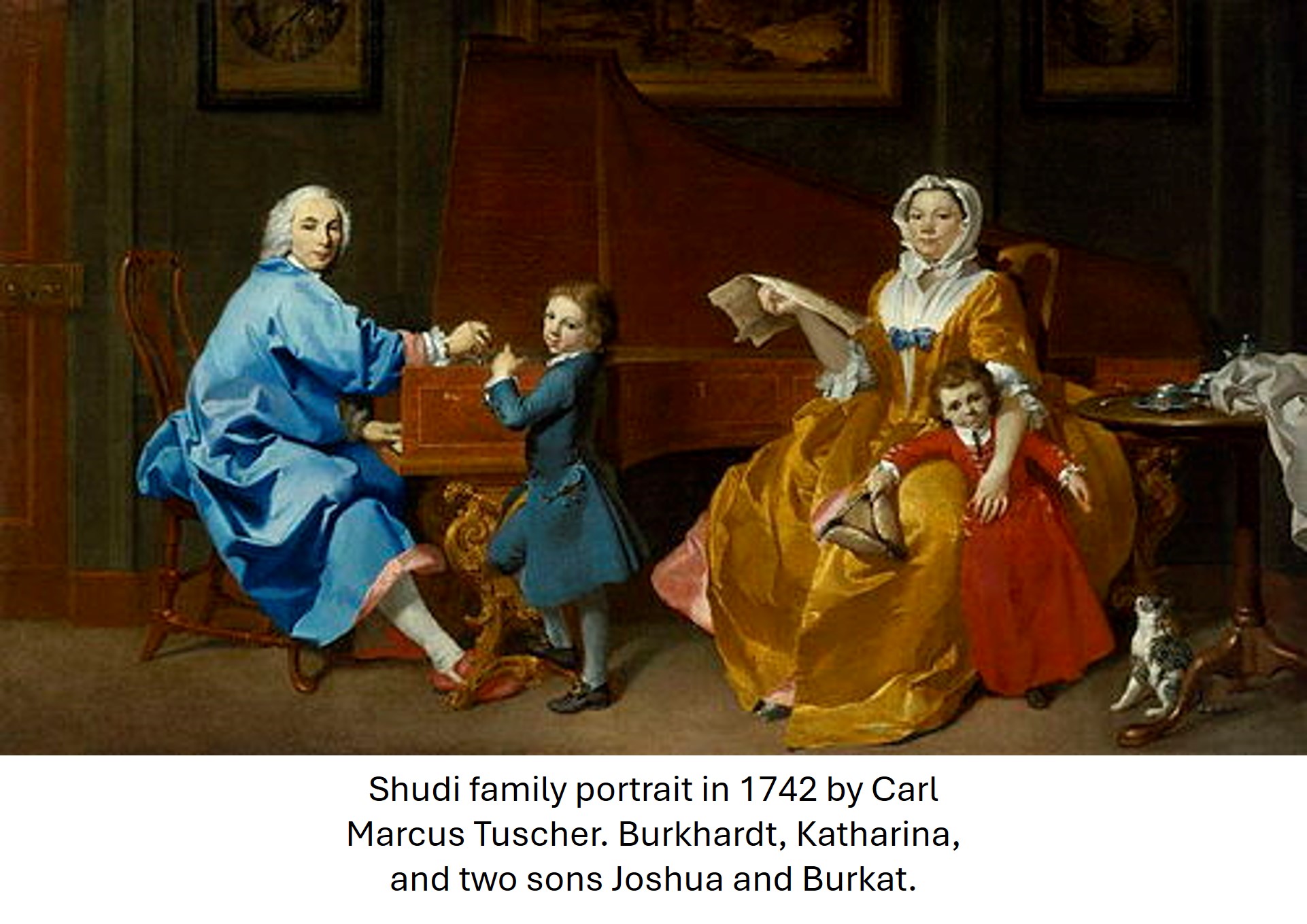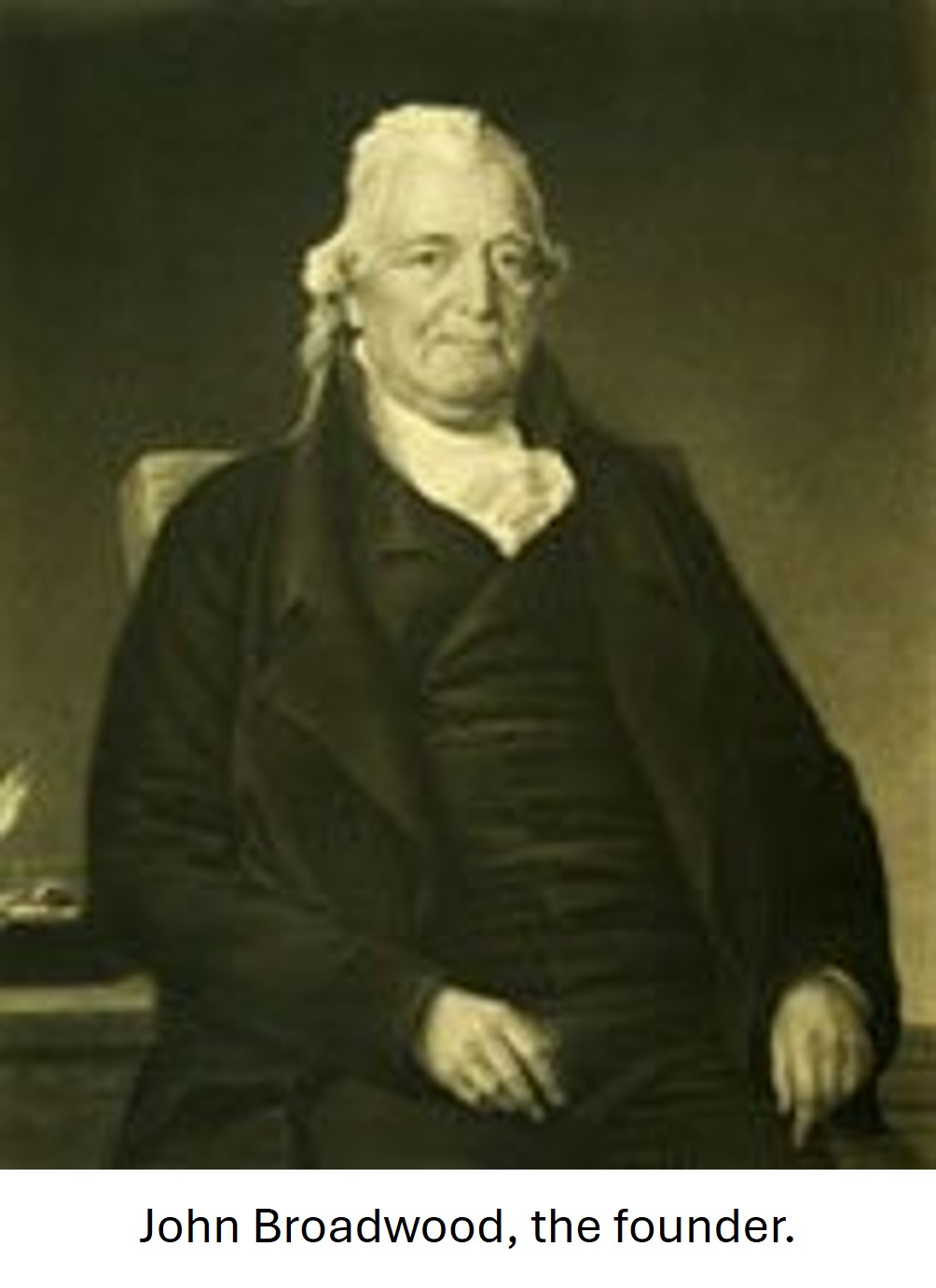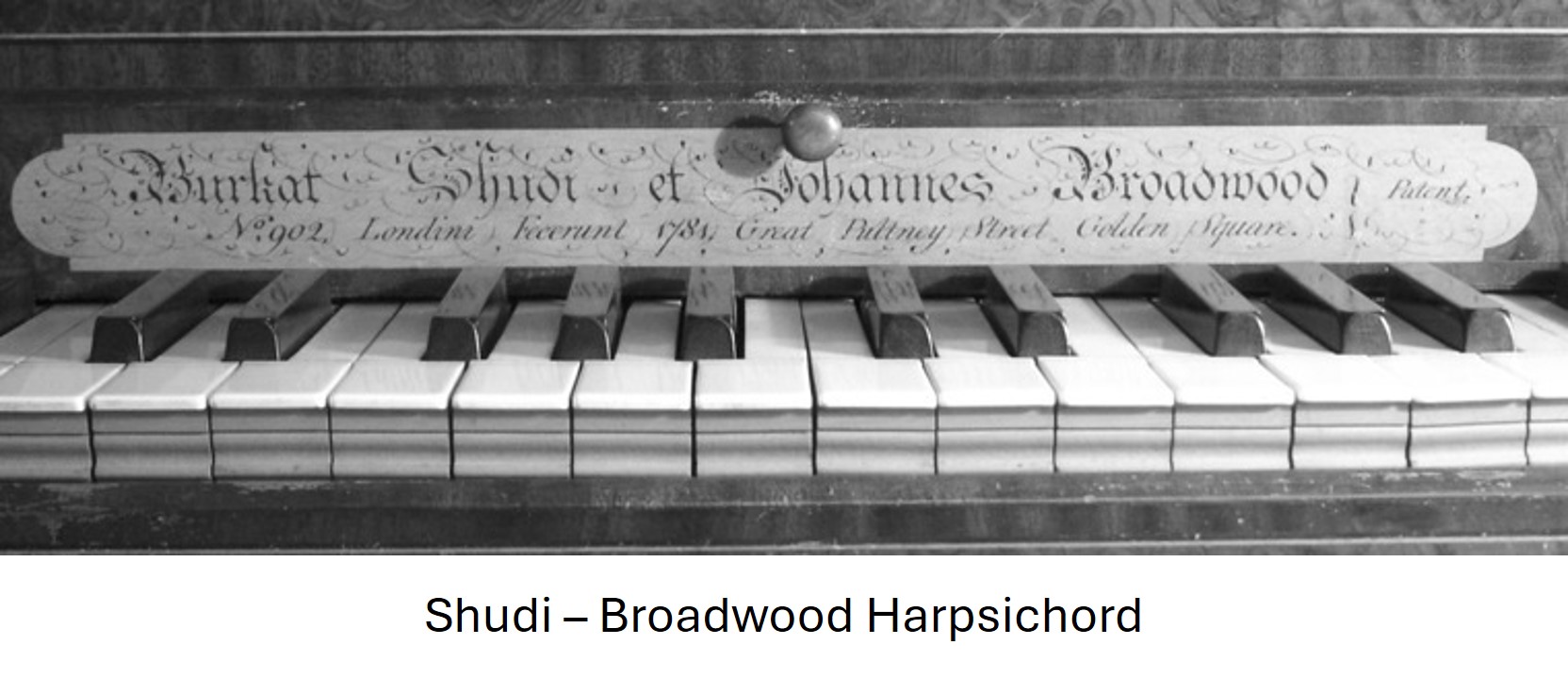




| 1718 | |
| Burkat Shudi came to London, aged 16, from Switzerland where his family were craftsmen in wood. He became an apprentice in the Soho harpsichord workshop of Hermann Tabel. Tabel had learnt his craft in the Antwerp workshop of the Ruckers family, the greatest harpsichord makers of the 17th century. Tabel is also notable since he took as apprentice two of the greatest harpsichord makers of the 18th century, Jacob Kirkman and Shudi. |  |
| 1728 | |
| Shudi started his own workshop. This was the foundation of the business now known as John Broadwood & Sons. | |
| 1729 | |
| Young Shudi (not yet 30) made a harpsichord for Handel, who wanted to give a special present to a soprano starring in his Italian opera season in London. | |
| 1740 | |
| Shudi built a harpsichord for Frederick, Prince of Wales (now in Kew Palace). Other instruments were made for his father King George II, and Broadwoods have made instruments for every British monarch since. Broadwood have held the Royal Warrant since 1742, longer than any other warrant holder. | |
| 1761 | |
| John Broadwood came to London from his native Scotland to seek his fortune. Aged 29, he was the eldest son of the village "wright" or carpenter of Oldhamstocks in the Lothian hills, south of Edinburgh. | |
| 1765 | |
| Nine-year-old Mozart, visiting London, played a Shudi harpsichord. |  |
| 1769 | |
| John Broadwood, a fine craftsman, married Barbara, Shudi's younger daughter. | |
| 1771 | |
| Shudi handed over the running of his business to his son Burkat and son-in-law John Broadwood. | |
| 1773 | |
| Shudi died, bequeathing the workshop to his son and his son-in-law John Broadwood, who became its effective head. | |
| THE PIANO | |
| 1700 - 1800 | |
| Meanwhile the 'piano-forte' was being developed to provide more variation of tone and greater volume than the harpsichord could offer. The first maker to create an instrument with hammers hitting the strings was the Italian, Cristofori, musical instrument maker to the Medici family. He had made three instruments on the style of the 'piano' by 1709. Pianos were developed across Europe during the 18th century. The earliest ones to come to London were 'square' pianos. A leading workshop (Silbermann) was in Freiberg, Germany. When this was closed down by the Seven Years War, twelve workmen ("the apostles") came to London. One of them, Johannes Zumpe, worked for Shudi - where he would have known John Broadwood - before starting his own workshop making square pianos. They were advertised in London from 1763, and Bach's son Johann Christian Bach played one in a London concert in 1767. Meanwhile John Broadwood joined with another Scot, Robert Stodart, and a Dutchman, Americus Backers, to design a piano in the harpsichord case - the origin of the 'grand'. They achieved this in about 1777. By 1778, when John Broadwood had been in charge of Shudi & Broadwood for five years, he was not only a leading maker of harpsichords, but experimenting with the new piano-forte also (one of his own make on Zumpe's pattern survives, dated 1774, in working order). | |
| THE COMPANY | |
| 1774 | |
| John Broadwood supplied harpsichords to the painters Reynolds and Gainsborough, and Josef Haydn in Vienna ordered one. He was also exporting to Russia, Denmark, Portugal, Italy, France, the West Indies, and America (where his agent was John Jacob Astor). |  |
| 1783 | |
| John Broadwood patented improvements in the piano, particularly the brass under-damper that made the square piano much more stable, and the English double action. | |
| 1784 | |
| By this date, John Broadwood was making more pianos than harpsichords. He sold 38 harpsichords, and 133 pianos, having increased production ten times in twelve years. | |
| 1785 | |
| Thomas Jefferson, later to become third President of the United States, visited the Broadwood factory in Great Pulteney Street, Soho, London to discuss musical instruments. | |
| 1788 | |
| John Broadwood commissioned scientific research (Royal Society and British Museum) on the improvement of the piano. This resulted in the introduction of the 'divided bridge' on the grand, which improved the bass tone. |  |
| 1789-94 | |
| 'Additional keys' were added, increasing the keyboard from 5, to 5 1/2, then to 6 octaves. | |
| 1793 | |
| The last Broadwood harpsichords made. Other makers continued (e.g. Kirkman), but went out of business as pianos took the market. | |
| 1795 | |
| The Broadwood firm became 'John Broadwood & Son' with the introduction of John Broadwood's elder son James Shudi Broadwood, who was given a half-share of the firm. | |
| 1796 | |
| A grand piano was made as a present for the Queen of Spain, the case being designed by Thomas Sheraton, and decorated with Wedgwood medallions (now in the Boston Museum of Fine Art). | |
| 1798 | |
| By this time, Broadwood's main production included the grand piano and square piano. Whilst the 'upright grand' was introduced - a grand on its end, over 8 ft high - the cottage upright piano was yet to be produced. Important customers included the wives of Nelson and Wellington. | |
| 1808 | |
| The Broadwood firm became 'John Broadwood & Sons' with the introduction of John Broadwood's second son, Thomas. | |
| 1812 | |
| John Broadwood died leaving an immense estate. His sons increased production. | |
| 1817 | |
| Thomas Broadwood, touring Europe after the Napoleonic Wars, visited Beethoven in Vienna, and in 1818 sent him a six octave grand piano, triple-stringed (now in the National Museum of Hungary, Budapest). It was later owned by Franz Liszt. | |
| 1821 | |
| A Grand piano was delivered to King George IV at Brighton Pavilion. The grand was built using rosewood, with multiple brass inlays, a style which was now becoming fashionable. | |
| 1820-30 | |
| This period saw the introduction of metal bars to the grand, and a metal stringplate to the square, giving greater power and volume. | |
| 1836 | |
| Henry Fowler Broadwood (eldest surviving son of James Broadwood) joined the partnership, which he led through the century. | |
| 1840 | |
| Queen Victoria married Prince Albert, who bought a Broadwood square piano for Buckingham Palace, where the young couple made music with Mendelssohn. | |
| 1842 | |
| By this time, 2,500 pianos a year were being made in the great factory in Horseferry Road, Westminster, London. Broadwoods were one of the twelve largest employers of labour in London, in an industry that was still craft-based with all parts made in-house. | |
| 1845 | |
| Henry Fowler Broadwood commissioned scientists for advice, leading to the creation of a bolted iron frame for the grand piano, to rival the introduction of the American cast-iron frame. | |
| 1848 | |
| Chopin was provided with three Broadwood grands for his British tour - for his London lodging, London concerts, and Scottish concerts. | |
| 1856 | |
| The Broadwood Horseferry Road factory burned down. Only about 200 pianos were salvaged. Production continued elsewhere until the factory could be rebuilt. | |
| 1860s | |
| Broadwood craftsmen formed their own band, conducted by Mr Sullivan of the Royal Military School of Music, whose son Arthur played the big drum (to be the musical partner in Gilbert & Sullivan). A grand piano in satinwood, inlaid "in the style of Sheraton," was designed by the Broadwood workshop to the order of Richard D'Oyly Carte, who was the impresario of Gilbert and Sullivan's Savoy Operas, and the first Chairman of the Savoy Hotel. The piano is now in the Royal Suite at Claridges, London. | |
| 1866 | |
| The last square piano made by Broadwoods - the model being overtaken in the home by the 'cottage upright'. | |
| 1867 | |
| At the Paris Exhibition, the Emperor Napoleon II presented the Gold Medal to Henry Broadwood. | |
| 1871 | |
| At the Centenary of Beethoven's birth, celebrated in Bonn, Charles Halle played a Broadwood grand. | |
| 1878 | |
| Grand pianos were designed in 'special' cases for the artist Lawrence Alma Tadema, Edward Burne-Jones and William Morris. Other customers in this period included Conan Doyle, Henry lrving, and Edward Elgar. | |
| 1886 | |
| Franz Liszt provided the testimonial "At this concert, Gosvenor Gallery, 8th April, I played with pleasure on this admirable Broadwood grand pianoforte." This testimonial refers to the magnificant 'Chopin' Broadwood concert grand of 1845, now on display at Finchcocks Musical Museum, Kent. | |
| 1888 | |
| Broadwood patent for improvements in the metal frame, leading to the 'barless' concert grand, with overstringing (despite challenges from Germany and America). 'The Broadwood Barless Piano', by Alastair Laurence, is available from John Broadwood & Sons, 2 John Street, Whitby, North Yorkshire, YO21 3ET. | |
| 1890s | |
| 'Special' piano cases were designed by leaders of the arts-and-crafts movement, including C R Ashbee and Hugh Baillie Scott, during this period. | |
| 1902 | |
| The Broadwood factory was moved to Old Ford, Hackney, with new machinery and methods. Cuthbert Heath, the "father of British insurance", became Chairman, his sister Ada having married John Broadwood's son Henry John Tschudi Broadwood. |  |
| 1902-10 | |
| During this period, player-pianos (self-playing pianos) were made. In 1910, a Broadwood player-piano went on Captain Scott's Antarctic expedition, was taken to the first base-camp, and played on the ice. | |
| 1914-18 | |
| The Broadwood factory was turned over to aircraft manufacture. It is said that the early biplanes were held together with piano-wire: they were. | |
| 1919-39 | |
| Difficult times for the piano trade generally. Broadwoods diversified (briefly) into gramophones. Production moved to Hendon. A new independent factory was opened on a modest scale in Acton in 1939, under the chairmanship of Captain Evelyn Broadwood. | |
| 1952 | |
| Broadwoods supplied a piano to HMS Gothic for HM the Queen's first tour abroad. | |
| 1954 | |
| HM Yacht Britannia equipped with numerous Broadwood pianos. | |
| 1977 | |
| A 'silvered frame' Broadwood grand piano was accepted by HM the Queen for Balmoral to mark the Silver Jubilee. | |
| 1978 | |
| The 250th Anniversary of John Broadwood & Sons marked with a concert on the South Bank (at which Malcolm Binns played five Broadwood pianos made between 1787 to 1978) and a dinner at The Savoy, where a congratulatory message from HM the Queen was read. | |
| 1981 | |
| A Broadwood grand piano was accepted as a wedding present by the Prince and Princess of Wales for Kensington Palace. | |
| 1986 | |
| A Broadwood upright piano was designed by Viscount Linley and his partner Matthew Rice. This was produced as a limited edition in sycamore veneer with ebony banding and marquetry panels. | |
| 1988 | |
| The legendary Broadwood `barless' upright piano was re-introduced. | |
| 1997 | |
| A new 'barless' grand piano was added to the product range and received its debut at a concert at the Royal College of Music, London, on the 27th November of that year. | |
| 2003 | |
| Broadwood piano production commences in a small factory at Moss in Norway. The famous `green frame' upright is revived, and one of these is supplied to the new Norwegian Opera House in Oslo. | |
| 2008 | |
| For the first time in many years, the company changes hands. The new chairman is Dr Alastair Laurence, and his son Sam Laurence becomes the company secretary. In fact, the Laurence family ties with Broadwoods go back to the year 1787. To coincide with the change in ownership, new restoration and conservation workshops are under construction at Finchcocks, Goudhurst, Kent, England. | |
| 2011 | |
| During June-July, Broadwoods sponsor a square piano competition held at the Geelvinck Festival, Geelvinck Museum, Amsterdam, Netherlands. | |
| 2013 | |
| On 11th-14th July, in Buckingham Palace gardens, to commemorate the 60th anniversary of the Queen's Coronation, the Broadwood firm, as a Royal Warrant holder, mounts an impressive display of its products. A Broadwood concert grand in an attractive marquee is seen and heard by the thousands of visitors attending. | |
| 2014 | |
| On 4th January, Dr Alastair Laurence, the company's chairman, is interviewed on BBC Radio 4 by pianist Jamie Cullum during an extended programme about piano manufacture in Camden Town, north London. | |
| 2014 | |
| In November, Broadwood vacates its old headquarters based at Finchcocks, Goudhurst, Kent, and re-locates to the attractive rural village of Lythe, near Whitby, on the Yorkshire coast. | |
| 2016 | |
| On 4th-5th June, the company holds a Broadwood Festival at its home village of Lythe, North Yorkshire, when two square pianos (including Queen Victoria's), four grand pianos, an upright piano and an electronic keyboard are on display, as well as a large presentation of Broadwood company history. Evening events include two concerts, at which there is a large local support. | |
| 2018 | |
| To commemorate the 200th anniversary of Thomas Broadwood's gift of a grand piano to the composer Ludwig van Beethoven, a series of concerts and exhibitions take place throughout Europe, in Vienna, Bonn and Budapest. In London, three recitals are held at the Royal Academy of Music on a 'Beethoven period' Broadwood grand. | |
| 2018 | |
| The Broadwood Harpsichord Competition, which has been sponsored for many years by the Broadwood Trust, continues to be held - these days sponsored by the Broadwood company, in association with the Horniman Museum, Forest Hill, London SE23. | |
| 2019 | |
| Gustav Holst's Broadwood grand piano, on which he composed the famous Planets' Suite, is rediscovered. After undergoing restoration in Broadwood's Lytle workshops, the piano is returned to its original home at St Paul's School, Hammersmith, London, for a concert performance on the 21st of September (Holst's birthday). | |
| 2021 | |
| For the first time in its 290-year history, the Broadwood company began to manufacture clavichords. | |
| 2022 | |
| Following the demolition of the old Broadwood factory at Old Ford, east London, a new thoroughfare of shops and housing was created on the factory site, and was named Broadwood Street in commemoration of the area's long business and cultural links with the company. The official opening of the street was on 20th October, when director Sam Laurence and members of the original Broadwood family attended the ceremony. | |
| 2024 | |
| 18th December: the company's Royal Warrant was renewed by King Charles III. Broadwoods are believed to be the oldest of the Royal Warrant holders, with appointments dating as far back as the year 1742. Currently, the company regularly tunes and maintains a total of eigth pianos in the various royal palaces. | |
| 2025 | |
| February: for the first time in its long history, the company opens a general music store at 2 John Street, Whitby, North Yorkshire (Phone: 07770 772233). In addition to stocking pianos, the new shop provides a wide variety of musical instruments, ranging from guitars, ukuleles and mandolins, to mouthorgans and recorders. Also, accessories such as strings, music stands and percussion items required by the musical fraternity are available. |